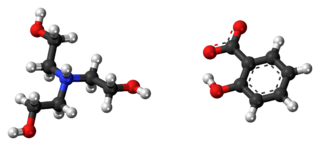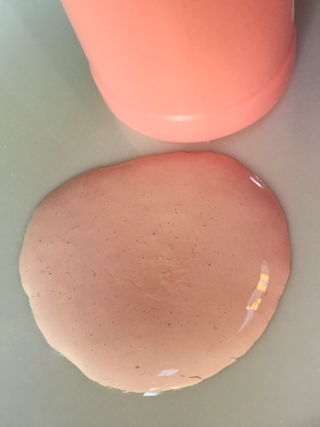Related Research Articles

Acetophenone is the organic compound with the formula C6H5C(O)CH3. It is the simplest aromatic ketone. This colorless, viscous liquid is a precursor to useful resins and fragrances.
Methyl violet is a family of organic compounds that are mainly used as dyes. Depending on the number of attached methyl groups, the color of the dye can be altered. Its main use is as a purple dye for textiles and to give deep violet colors in paint and ink. It is also used as a hydration indicator for silica gel. Methyl violet 10B is also known as crystal violet and has medical uses.

Benadryl is a brand of various antihistamine medications used to stop allergies, whose content varies in different countries, but which includes some combination of diphenhydramine, acrivastine, and/or cetirizine.

Methyl salicylate (oil of wintergreen or wintergreen oil) is an organic compound with the formula C8H8O3. It is the methyl ester of salicylic acid. It is a colorless, viscous liquid with a sweet, fruity odor reminiscent of root beer (in which it is used as a flavoring), but often associatively called "minty", as it is an ingredient in mint candies. It is produced by many species of plants, particularly wintergreens. It is also produced synthetically, used as a fragrance and as a flavoring agent.

A topical medication is a medication that is applied to a particular place on or in the body. Most often topical medication means application to body surfaces such as the skin or mucous membranes to treat ailments via a large range of classes including creams, foams, gels, lotions, and ointments. Many topical medications are epicutaneous, meaning that they are applied directly to the skin. Topical medications may also be inhalational, such as asthma medications, or applied to the surface of tissues other than the skin, such as eye drops applied to the conjunctiva, or ear drops placed in the ear, or medications applied to the surface of a tooth. The word topical derives from Greek τοπικόςtopikos, "of a place".

Clobetasol propionate is a propionate ester of the corticosteroid clobetasol. Clobetasol propionate used to treat skin conditions such as eczema, contact dermatitis, seborrheic dermatitis, steroid responsive dermatosis, and psoriasis.

George's Marvellous Medicine is a children's novel written by Roald Dahl and illustrated by Quentin Blake. First published by Jonathan Cape in 1981, it features George Kranky, an eight-year-old boy who concocts his own miracle elixir to replace his tyrannical grandmother's regular prescription medicine.

Terbinafine is an antifungal medication used to treat pityriasis versicolor, fungal nail infections, and ringworm including jock itch and athlete's foot. It is either taken by mouth or applied to the skin as a cream or ointment. The cream and ointment should not be used for fungal nail infections.

Trolamine salicylate is an organic compound with the chemical formula [HN(CH2CH2OH)3]+C6H4(OH)(COO−). It is a salt of triethanolamine and salicylic acid, i.e. the compound consists of protonated triethanolamine and the conjugate base of salicylic acid, salicate.

Calamine, also known as calamine lotion, is a medication made from powdered calamine mineral that is used to treat mild itchiness. Conditions treated include sunburn, insect bites, poison ivy, poison oak, and other mild skin conditions. It may also help dry out secretions resulting from skin irritation. It is applied on the skin as a cream or lotion.
Monoterpenes are a class of terpenes that consist of two isoprene units and have the molecular formula C10H16. Monoterpenes may be linear (acyclic) or contain rings (monocyclic and bicyclic). Modified terpenes, such as those containing oxygen functionality or missing a methyl group, are called monoterpenoids. Monoterpenes and monoterpenoids are diverse. They have relevance to the pharmaceutical, cosmetic, agricultural, and food industries.

Chocolate ice cream is ice cream with natural or artificial chocolate flavoring. One of the oldest flavours of ice creams, it is also one of the world's most popular. While most often sold alone, it is also a base for many other flavours.

β-Methylphenethylamine is an organic compound of the phenethylamine class, and a positional isomer of the drug amphetamine, with which it shares some properties. In particular, both amphetamine and β-methylphenethylamine are human TAAR1 agonists. In appearance, it is a colorless or yellowish liquid.

Mepyramine, also known as pyrilamine, is a first-generation antihistamine, targeting the H1 receptor as an inverse agonist. Mepyramine rapidly permeates the brain, often causing drowsiness. It is often sold as a maleate salt, pyrilamine maleate.

Mestanolone, also known as methylandrostanolone and sold under the brand names Androstalone and Ermalone among others, is an androgen and anabolic steroid (AAS) medication which is mostly no longer used. It is still available for use in Japan however. It is taken by mouth.
p-Chlorocresol, or 4-chloro-3-methylphenol (ClC6H3CH3OH), also known as p-chloro-m-cresol, is a potent disinfectant and antiseptic. It appears as a pinkish white crystalline solid. It is also used as a preservative in cosmetics and medicinal products for both humans and animals. It is used as an active ingredient in some preparations of veterinary medicines for tropical, oral and parenteral use. Normally, the concentration of p-Chlorocresol in oral and parenteral veterinary products are 0.1-0.2%. Concentrations are higher (~0.5%) in tropical veterinary products. p-Chlorocresol contains microbial activity against both gram positive and gram negative bacteria and fungi.
Substituted amphetamines, or simply amphetamines, are a class of compounds based upon the amphetamine structure; it includes all derivative compounds which are formed by replacing, or substituting, one or more hydrogen atoms in the amphetamine core structure with substituents. The compounds in this class span a variety of pharmacological subclasses, including stimulants, empathogens, and hallucinogens, among others. Examples of substituted amphetamines are amphetamine (itself), methamphetamine, ephedrine, cathinone, phentermine, mephentermine, tranylcypromine, bupropion, methoxyphenamine, selegiline, amfepramone (diethylpropion), pyrovalerone, MDMA (ecstasy), and DOM (STP).

Animocarb (Matacil) is an organic chemical compound with the molecular formula C11H16N2O2. It has a colorless or white crystal-like appearance and is most commonly used as an insecticide.

Vegetable soup is a common soup prepared using vegetables and leaf vegetables as primary ingredients. It dates to ancient history, and is a mass-produced food product in contemporary times.
References
- ↑ Ratcliffe, Lucy V.; Rutten, Frank J. M.; Barrett, David A.; Whitmore, Terry; Seymour, David; Greenwood, Claire; Aranda-Gonzalvo, Yolanda; Robinson, Steven; McCoustra, Martin (2007). "Surface Analysis under Ambient Conditions Using Plasma-Assisted Desorption/Ionization Mass Spectrometry" (PDF). Analytical Chemistry . 79 (16). American Chemical Society: 6094–6101. doi:10.1021/ac070109q. PMID 17628043.[ permanent dead link ]
- ↑ Penny Blanch (2001). Saving Money on Medicines: The Drugs Budget Handbook. Radcliffe Medical. p. 155. ISBN 9781857754339.
- ↑ Steven B. Kayne, ed. (2006). Sport and Exercise Medicine for Pharmacists. Pharmaceutical Press. p. 166. ISBN 9780853696001.